Crowhurst, George 'Angelo' (McKechnie Section 1)
See Section Two for main entry
Although about half the number of authenticated profiles by Crowhurst were cut, and half painted on paper or card, convenience dictates that the main entry on him should be in Section Two, since the examples of his painted work can be illustrated there collectively.
139, 214, 215, 265
Of his cut profiles one is illustrated in Chapter Five, two are illustrated in Chapter Seven, and another (not fully authenticated) is illustrated in Chapter Nine. One example is illustrated in this Section.
Of the five illustrated cut profiles, the four authenticated examples represent members of the Ogle family. They all show similar work. They are cut from dark-grey paper, and full details of the sitters' clothing are shown by rough but effective brushwork and thinned black water-colour. Chinese white is used to show the strands of the hair and the neckwear; jewellery is shown in gold. On the portraits of men, where a white collar has to be shown the outline of the head has been cut separately in the style also used by W. H. Beaumont. The same technique appears to have been used to show a white cuff at the wrist. These portraits stand on a deep wash base, the upper part being painted in a paler wash.
Crowhurst's use of Wedgwood blue work, discussed in Section Two, should also be mentioned here. In several of his full-length cut silhouettes, especially those of children, he paints the sitters' clothing in this distinctive colour, shaded with black and sepia. The hair is painted in gold against black, the face being in black. Buttons, and other ornaments or accessories (such as a basket held by the sitter), are painted in gold. Touches of Chinese white, much used by Crowhurst, complete the portraits. Boys are seen holding whips or other toys, girls with posies of flowers, shown in colour, or small gilt decorated baskets. I have seen one group of five children painted in this style; it is in private possession. Crowhurst’s profiles of this type show the figures standing on bases of a greyish tinge; he sometimes leaves a circle around the child sitter's feet clear of pigment, and carefully paints in the shadow thrown by the figure. Some examples have seascape backgrounds. Examples of these silhouettes have been seen in Brighton as well as in other parts of the country, but, since none are signed, they lack definite provenance. Nevertheless, since Crowhurst does specify his unusual use of Wedgwood blue in one of his advertisements it does seem likely that silhouettes of this kind would be from his hand.
Both the 'Wedgwood blue' and the signed cut examples are characterised by an absence of gum arabic. The 'Wedgwood blue' type of work has been seen framed in rosewood, with giltwood surrounds.
Ills. 139, 214, 215, 265, 329, 632, 643
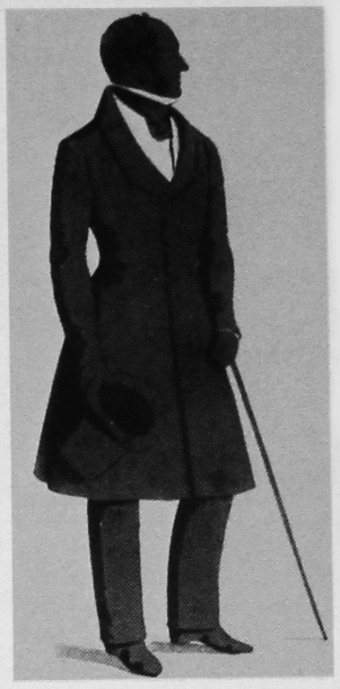
Robert Ogle, Senior.
Silhouette by George Crowhurst, July 1835. This is a typical silhouette of the mid-1830s.
costume dating points
The hair, cut close at the back of the head, and the whiskers.
The Cumberland hat, held in the hand.
The black cravat, popular during this decade.
The waistcoat (apparently single-breasted).
The double-breasted paletot, seamless at the waist and knee-length. The sleeve is slightly gathered at the shoulder, and the cuff arches over the hand.
The subject is probably wearing ‘demi-large’ pantaloons, with plain round bottoms, and unstrapped. The absence of shoe-strings indicates that he is wearing them with half-boots.
The cane, of the length fashionable during the 1830s.
Author’s collection
CHAPTER 7
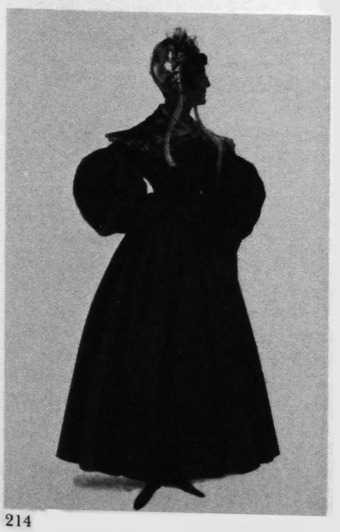
Mrs Robert (Jane) Ogle.
Silhouette by George Crowhurst, taken at 40 Old Steine, Brighton, July 1835.
costume dating points
The tiny knot, perched on top of the sitter’s head.
The round cap of the 1830s, fitting to the shape of the head.
The dainty watch, on a long fine chain hung from the neck, and pendant earrings.
The neckwear is probably the large turn-down collar of the period; since it is not wide enough to cover the top of the sleeves, it is probably not a pèlerine.
The dress with draped bodice (type 4), as described in the text under ‘1820-30’.
The sleeves of the gigot type (not as large as those in 215).
The shoes, slightly square-toed and apparently made of two-toned leather.
The plain skirt, much like that of the sitter’s daughter in 215.
Author’s collection
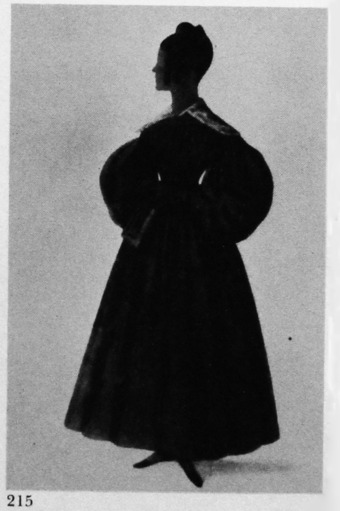
Miss Jane Ogle.
Silhouette by George Crowhurst, July 1835.
costume dating points
The hair, dressed in the third style described in the text under ‘ 1830-40’.
The Apollo knot is now very much smaller.
The turn-down collar of the 1830s; rather broad, but not as broad as the pèlerine.
The closely fitting bodice en gerbe.
The sleeves of the ‘imbecile’ type.
The plain skirt, reaching to the instep.
The shoe, slightly square-toed and longer than styles were to become in the 1840s.
Author’s collection
CHAPTER 9

Unknown girl (aged about twelve).
Silhouette by an unknown artist, possibly George Crowhurst, 25 April 1844. The sitter’s hair is painted in gold, her dress in Wedgwood blue.
costume dating points
The hair, flat at the sides, drawn back behind the ears (though not as tightly as that of the girl shown in 266, whose silhouette was taken in c. 1850), and secured at the nape of the neck.
The dress, longer than that shown in 266, and nipped in more at the waist, with a Bertha top (like that worn by women at the time), and with an ankle-length skirt without flounces, though less full than skirts of the 1850s.
The sleeve, full at the elbow only (typical of the 1840s).
The flat black shoe of the sandal type, tied above the ankle.
Coloured shoes were out of fashion for children by this date.
Author’s collection
SECTION ONE

Robert Ogle, Junior
Cut silhouette
July 1835
10½ x 7in./267 x 178mm.
Taken at 40 Old Steine, Brighton.
Author’s collection
DETAIL
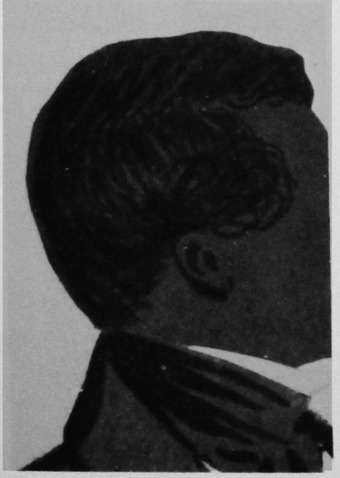
Detail from a full-length silhouette of a man by George Crowhurst, showing the sitter’s hair, indicated by coarse but effective brushwork. (329)
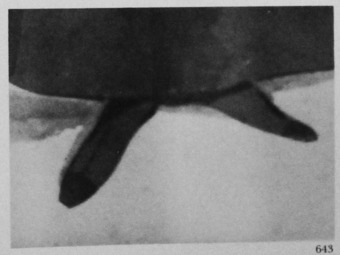
Detail from a silhouette of a woman ba George Crowhurst, showing the artist’s style of rendering the sitter’s feet.
